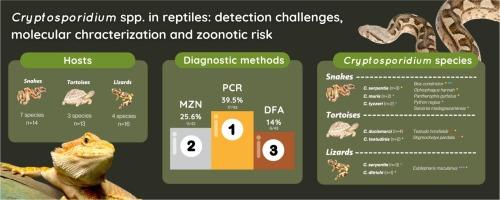Cryptosporidium spp. in reptiles: Detection challenges, molecular characterization and zoonotic risk
IF 3.1
Q2 PARASITOLOGY
引用次数: 0
Abstract
Cryptosporidium genus includes protozoan parasites that pose significant health risks to a wide range of hosts, including reptiles. Understanding their prevalence and molecular characteristics is crucial for addressing the diagnostic challenges and potential zoonotic transmission associated with these organisms. This research focuses on the prevalence and molecular characterization of Cryptosporidium spp. in reptiles, highlighting the diagnostic challenges and potential risks for zoonotic transmission. A total of 43 reptile fecal samples from 14 different species were examined using three diagnostic techniques: polymerase chain reaction (PCR), modified Ziehl-Neelsen staining (MZN), and direct immunofluorescence antibody test (DFA). The findings revealed a positivity rate of 41.9 % (18/43) for Cryptosporidium spp., with PCR showing the highest sensitivity at 94.4 %, followed by MZN at 61.1 %, and DFA at 33.3 %. Sequence analysis identified six distinct species of Cryptosporidium, including zoonotic species like C. muris, C. tyzzeri, and C. ditrichi, which raises significant public health concerns as reptiles become increasingly popular as pets. The study points out the limitations of conventional diagnostic methods and the need for improved diagnostic approaches, which should include Cryptosporidium species identification.

爬行动物中的隐孢子虫:检测挑战、分子表征和人畜共患风险
隐孢子虫属包括对包括爬行动物在内的多种宿主构成重大健康风险的原生动物寄生虫。了解其患病率和分子特征对于解决诊断挑战和与这些生物相关的潜在人畜共患传播至关重要。本研究的重点是爬行动物隐孢子虫的流行和分子特征,强调了人畜共患传播的诊断挑战和潜在风险。采用聚合酶链反应(PCR)、改良Ziehl-Neelsen染色(MZN)和直接免疫荧光抗体试验(DFA) 3种诊断技术,对来自14个不同种类的43份爬行动物粪便进行了检测。结果显示,隐孢子虫的阳性检出率为41.9% (18/43),PCR检测灵敏度最高,为94.4%,其次为MZN (61.1%), DFA(33.3%)。序列分析鉴定出六种不同的隐孢子虫,包括人畜共患的隐孢子虫,如C. muris, C. tyzzeri和C. ditrichi,随着爬行动物越来越受欢迎作为宠物,这引起了重大的公共卫生问题。该研究指出了传统诊断方法的局限性和改进诊断方法的必要性,其中应包括隐孢子虫的种类鉴定。
本文章由计算机程序翻译,如有差异,请以英文原文为准。
求助全文
约1分钟内获得全文
求助全文
来源期刊

Food and Waterborne Parasitology
Immunology and Microbiology-Parasitology
CiteScore
5.10
自引率
4.00%
发文量
38
审稿时长
13 weeks
期刊介绍:
Food and Waterborne Parasitology publishes high quality papers containing original research findings, investigative reports, and scientific proceedings on parasites which are transmitted to humans via the consumption of food or water. The relevant parasites include protozoa, nematodes, cestodes and trematodes which are transmitted by food or water and capable of infecting humans. Pertinent food includes products of animal or plant origin which are domestic or wild, and consumed by humans. Animals and plants from both terrestrial and aquatic sources are included, as well as studies related to potable and other types of water which serve to harbor, perpetuate or disseminate food and waterborne parasites. Studies dealing with prevalence, transmission, epidemiology, risk assessment and mitigation, including control measures and test methodologies for parasites in food and water are of particular interest. Evidence of the emergence of such parasites and interactions among domestic animals, wildlife and humans are of interest. The impact of parasites on the health and welfare of humans is viewed as very important and within scope of the journal. Manuscripts with scientifically generated information on associations between food and waterborne parasitic diseases and lifestyle, culture and economies are also welcome. Studies involving animal experiments must meet the International Guiding Principles for Biomedical Research Involving Animals as issued by the Council for International Organizations of Medical Sciences.
 求助内容:
求助内容: 应助结果提醒方式:
应助结果提醒方式:


